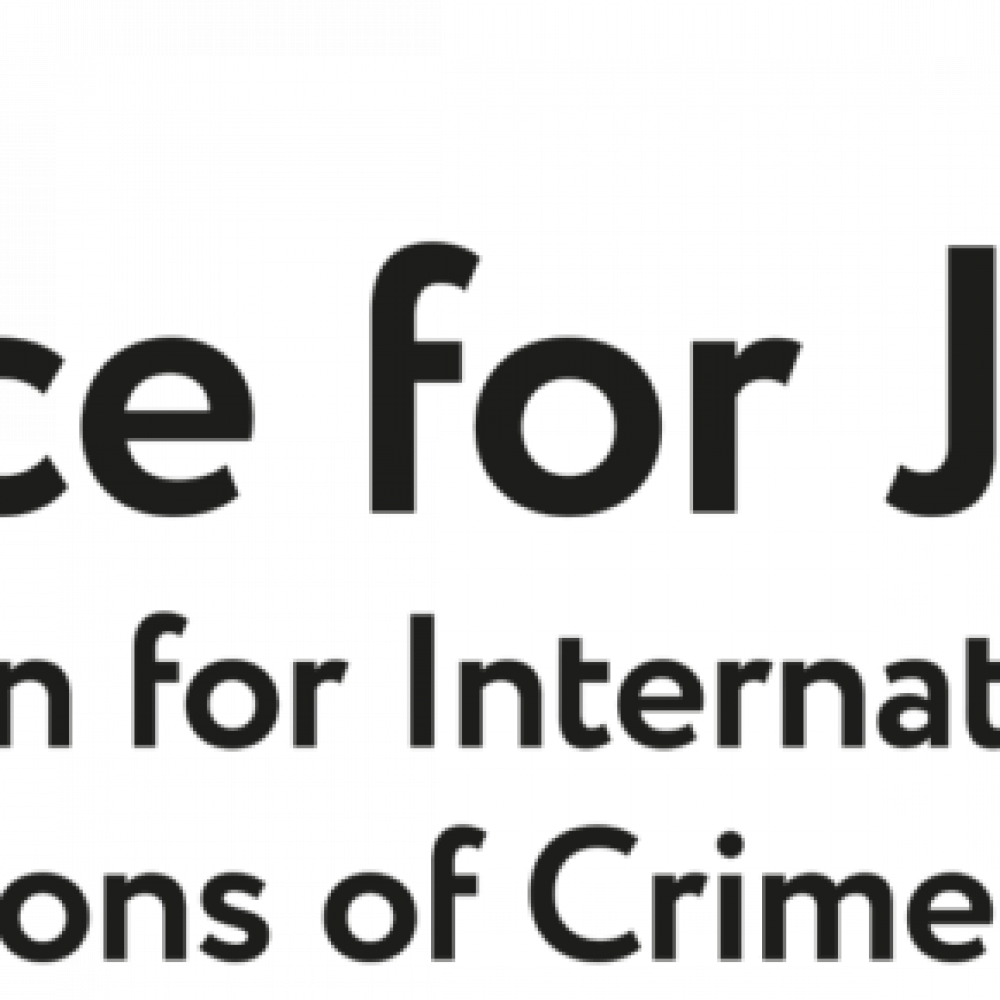AUTHOR OF THE REPORT: THE COMMITTEE TO PROTECT FREEDOM OF EXPRESSION (CPFE)
PHOTO: PHOTOLURE NEWS AGENCY
1/ KEY FINDINGS
There were 163 attacks/threats against professional and citizen media workers, and editorial offices of traditional and online media outlets identified and analysed inthe course of the 2024 study for Armenia. Data for the study were collected using content analysis from open sources in Armenian, Russian and English. The list of the main sources is provided in Appendix 1.
- The total number of recorded attacks in 2024 – 163 – was the same as in 2023. This indicates how difficult conditions still are for journalists and that there remains insufficient protection of the rights of the media and their staff.
- The number of physical attacks on journalists was four times greater than in 2023. Recorded attacks on journalists and cameramen occurred mainly while they were covering mass protests.
- At the same time, the number of attacks and threats of a non-physical nature and/or cyberattacks fell by a third: there were 31 recorded incidents in 2024 compared to 46 in 2023. 74% of these attacks and threats (23 cases) were perpetrated by government officials.
- The number of attacks via judicial and/or economic means did not change significantly: there were 108 recorded cases. The number of such attacks initiated by government officials has halved compared to 2023.
2/ THE POLITICAL SITUATION AND THE MEDIA IN ARMENIA
The reports of international organizations published in 2024 indicated both negative and positive developments in the area of freedom of speech and media activities in Armenia. The international NGO Reporters Without Borders (RSF) placed Armenia 43rd in its annual ranking, six places higher than in 2023. RSF considered it a significant achievement that the country had created a favourable environment for the pluralism of opinions. In its report, “Freedom on the Internet 2024”, the international human rights organisation Freedom House, ranked Armenia among the countries with a free Internet, awarding it 74 points, which is 2 points higher than in the previous year. This assessment was based on the fact that during the period under review there were no cases of blocking of websites and/or social networks. At the same time, both organizations drew the authorities’ attention to the lack of legal protection for journalists.
The first months of 2024 were politically calm, and not a single case of physical violence against journalists was recorded. However, in the second quarter, the country was swept by anti-government rallies and marches related to the delimitation of the border between Armenia and Azerbaijan. Protesters accused the authorities of betraying national interests, ceding Armenian territories to Azerbaijan, implementing domestic policies according to Baku’s instructions, and threatening the sovereignty of Armenia. The protesters also demanded the immediate resignation of the government. Prime Minister Nikol Pashinyan’s team accused the leaders of the protest movement of provoking a new war between Azerbaijan and Armenia, of damaging the peace process, and basically acting as the Kremlin’s fifth column.
Formally, this protest movement was led by the Archbishop of the Armenian Apostolic Church, Bagrat Galstanyan. He cooperated with the people who supported the leaders who were removed from power during the Velvet Revolution of 2018 and who today represent the radical opposition.
Mass protests were accompanied by clashes between police and demonstrators. Many media workers were injured while covering these events. The most extreme day was 12 June, when police used stun grenades against demonstrators near the parliament building. In the process, more than ten journalists and cameramen were injured, some of them received shrapnel wounds.
Cases have also been recorded of physical violence against journalists linked to material they published about these events and about the leader of the protest movement. From the end of April to late June, 13 cases of physical attacks on journalists and cameramen were recorded, as a result of which 22 media employees were injured. Although the Ministry of Internal Affairs initiated internal investigations into possible abuse of power by police officers and the Investigative Committee opened criminal cases, as of 31 December 2024, no one had been held accountable for the attacks.
During this period, the country’s public media organizations issued a number of statements condemning the violent actions against media representatives by both police officers and participants in the demonstrations and marches. International organizations also criticised the violence. In particular, in its press release widely distributed on May 22, RSF stated that journalists were being targeted by police officers and attacked on the orders of political figures. The organization called on the Armenian authorities “to immediately put an end to this violence and fight impunity by conducting an independent and transparent investigation into the attacks that took place”.
From mid-July, the wave of mass protests gradually died out, and by the autumn the protest movement had ceased completely. As a result, there was only one physical attack against a journalist recorded from July until the end of the year. This was also reflected in other types of violations of the rights of media representatives.
The polarisation of the media remained an acute problem throughout the year. The overwhelming majority are affiliated with various political forces and merely serve their interests to the detriment of the public interest. Different political forces are waging an information war and making society their hostage. In an attempt to discredit their opponents by any means, opposing sides widely use such tools as fake news, disinformation, the manipulation of facts, insults and slander. As a result, a number of serious incidents have occurred, both when opposition media have sought comments or interviews from officials of the ruling party, and when pro-government media workers have approached opposition figures. In some cases, there have been conflicts accompanied by insults and threats. These are described in more details in the relevant section of this report.
There were also some important positive developments in 2024 in the field of media legislation reforms. The draft law on amendments and additions to the law “On Mass Communication” deserves special mention. This was developed through the joint efforts of a number of the country’s media organizations, the Ministry of Justice of the Republic of Armenia, the relevant commission of the National Assembly and the international organization, Freedom House. It was submitted for discussion at parliamentary hearings on 29 April and later sent for review to the Venice Commission of the Council of Europe. In mid-October, the commission reached its conclusion and suggested a few recommendations, based on which the bill is currently being finalized for further submission to the government and parliament. The main aim of the proposed changes is to stimulate high-quality journalism, develop a system of self-regulation of the media based on the norms of professional ethics, and the recognition of this system by the state.
3/ GENERAL ANALYSIS OF ATTACKS
There were 163 attacks on media workers and media outlets in Armenia in 2024, exactly the same number as in 2023. Yet the number of cases of physical violence and threats to life, liberty and the health of journalists increased four-fold. At the same time, the number of attacks and threats of a non-physical nature and/or cyberattacks fell by 32%. There was a slight decrease (about 3%) in the number of attacks using judicial and/or economic means, but, overall, the situation remains unfavourable. It is worth noting that in 2024, all court cases against journalists and media outlets, without exception, were based on charges of insult, slander, and damage to reputation.

Of the 163 recorded incidents, 76 were perpetrated by representatives of the authorities. The main factors that led to violations of the rights of journalists and media outlets were:
- The government’s delimitation of the border between Armenia and Azerbaijan, which aggravated the socio-political situation. This led to mass protests, accompanied by numerous clashes, including attacks against journalists. Politically-biased coverage of these events by media affiliated to various parties and political figures stirred up trouble among the public;
- The atmosphere of hostility between the opposing political forces, the leaking of compromising materials and offensive rhetoric which was reflected in the media and social networks;
- The continued polarisation of the media, the overwhelming majority of outlets serving the interests of specific political forces to the detriment of the public interest, and the desire to discredit opponents at any cost, including ignoring the norms of journalistic ethics.
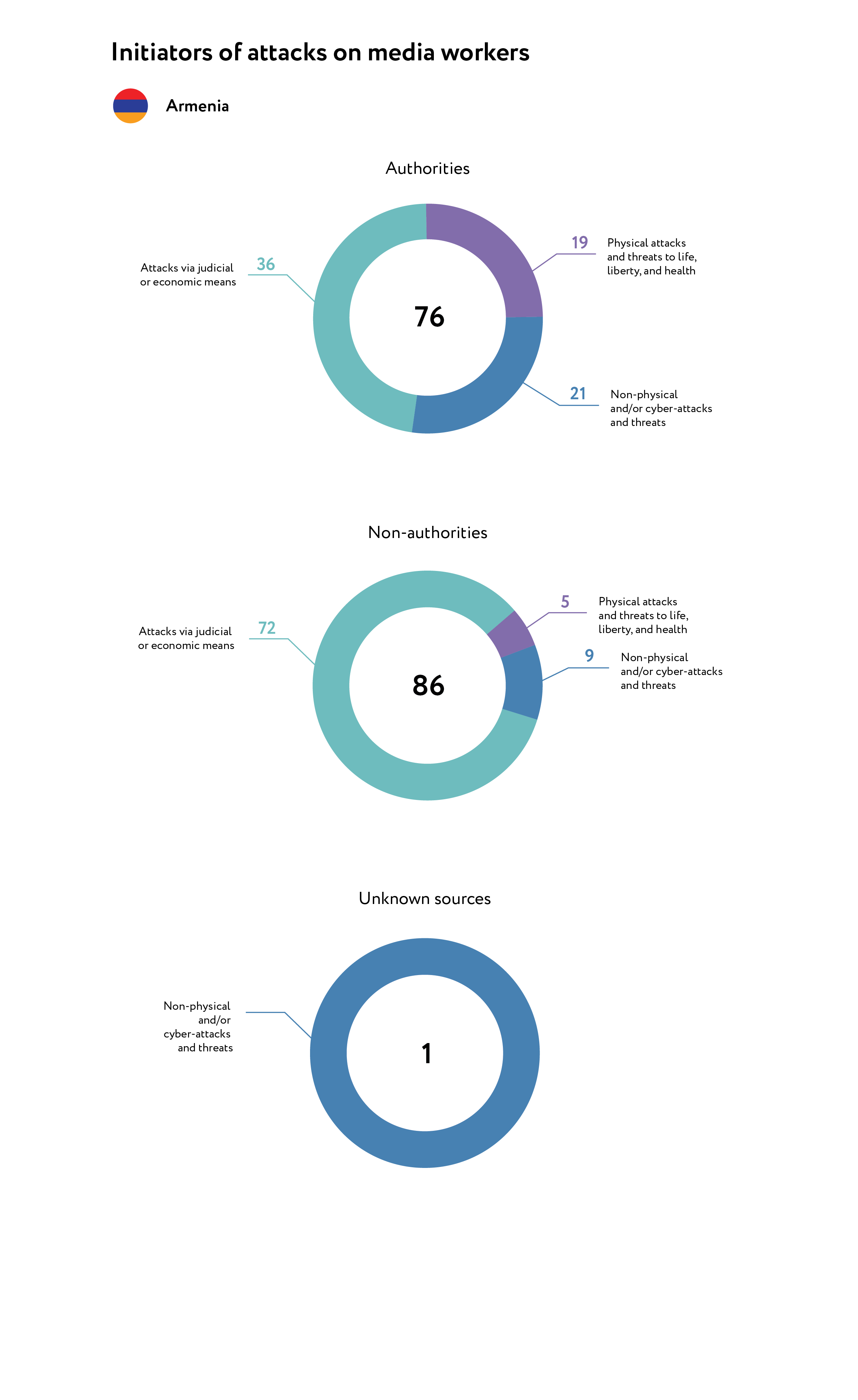
4/ PHYSICAL ATTACKS AND THREATS TO LIFE, LIBERTY AND HEALTH
A four-fold increase in cases of physical violence against media workers compared to the previous year is a cause for serious alarm, especially as there was a downward trend in such attacks in 2023.
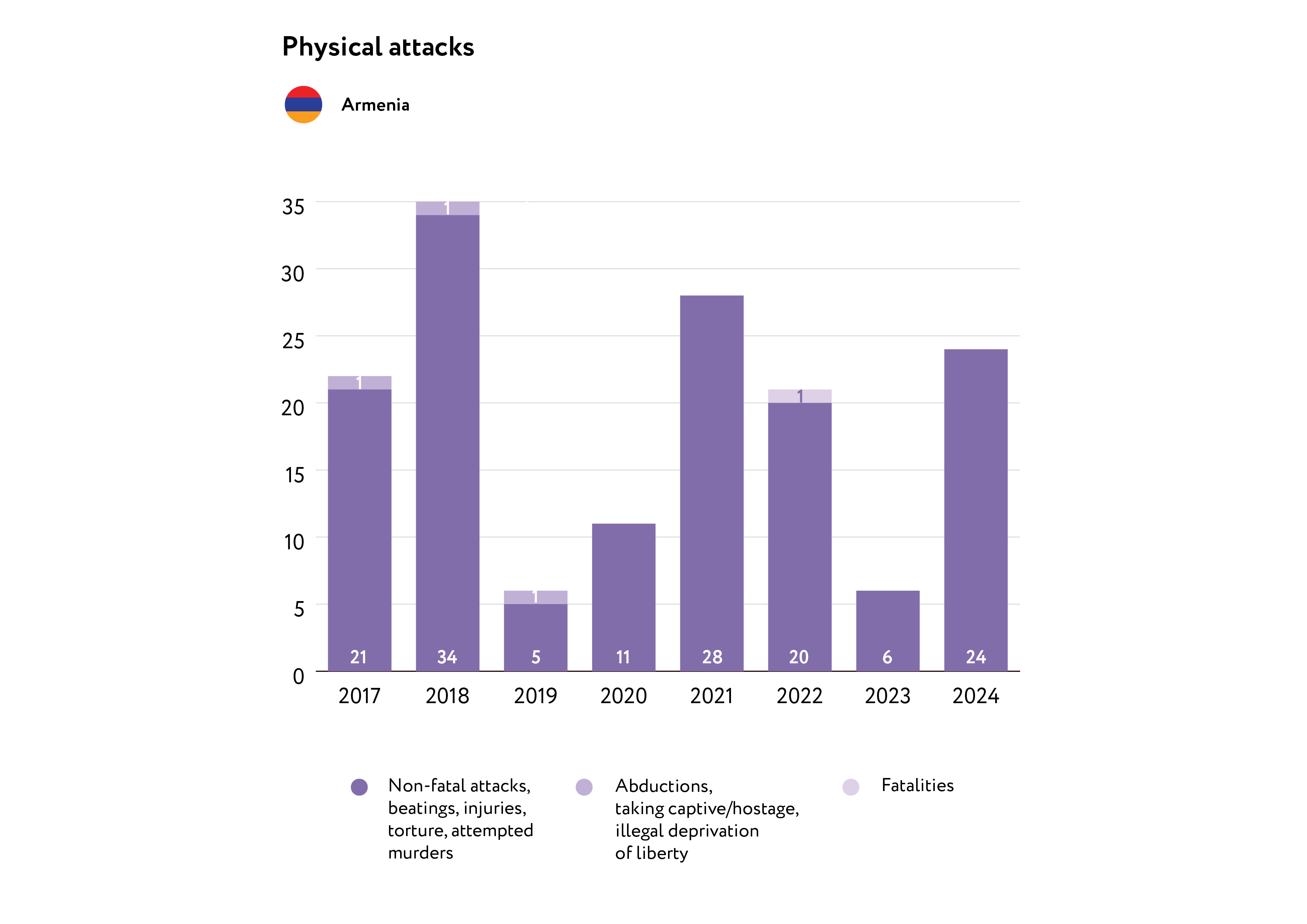
Of the 24 journalists and cameramen injured as a result of physical attacks in 2024, 22 were attacked in April-June, during the active phase of the protest movement, when mass rallies, demonstrations and marches were held. Outside of these events, two media workers were subjected to violence. Some of the physical attacks recorded in 2024 include:
- On 27 April, on the Ijevan-Kirants highway in the Tavush region of Armenia, masked police officers stopped a car carrying media workers covering the protests, forced everyone out, then knocked NewDay.am news website cameraman Janibek Khachatryan to the ground and handcuffed him. He repeatedly said that he is a media employee and that he and his colleagues were carrying out their professional duties, but this had no effect on the police. The cameraman was soon released, but no apology or explanation was given by the police.
- On 30 April, an altercation occurred at the entrance to the parliament building between a security guard and the accredited correspondent of the pro-government news website Civic.am, David Levonyan. The security guard, who was working for the opposition member of the National Assembly of the Republic of Armenia, Levon Kocharyan (son of the second President of Armenia Robert Kocharyan), then hit Levonyan in the face, accusing him of blasphemy. The incident was triggered by the journalist’s post on YouTube, in which he claimed that the head of the Tavush Diocese of the Armenian Apostolic Church, Bishop Bagrat Galstanyan, (see above, section 2), serves Russian interests.
- On 12 June, a protest organized by the opposition near the National Assembly of Armenia was broken up by the police using stun grenades. The explosions provoked a stampede, in which the following media workers were injured: a cameraman from the News.am websiteVazgen Yetumyan; a cameraman from Armlur.am Hovsep Hovsepyan; a cameraman from CivilNet Narek Hayryan; and ABCMedia journalists Nane Hayrapetyan and Aghvan Asoyan, with their cameramen Edik Malakyan and Arman Gharibyan; Mediahub.am correspondent Nareh Gevorgyan; AlphaNews journalist Arpineh Baghdasaryan; and cameraman Hovhannes Hakobyan.
- In the National Assembly on 14 November, when the parliamentary correspondent of the Hraparak daily newspaper, Lusineh Shahverdyan, tried to get a comment from the Minister of Justice, Srbuhi Galyan, a security officer standing nearby decided that the minister did not want to continue the conversation, grabbed the journalist by the arm and dragged her aside. Shahverdyan’s arm was bruised.
5/ NON-PHYSICAL AND/OR CYBER-ATTACKS AND THREATS
There were 32% fewer incidents recorded in 2024 than in 2023: 31 against 46. The main ways in which the rights of journalists and camera crews were violated were harassment, intimidation, pressure, and threats of violence and death. This was done by cyberattack (15 cases), and illegal obstruction of professional activities or denial of access to information (nine cases). There were also five cases of damage to or seizure of property, transport, equipment, documents or journalistic materials and two cases of discrediting and spreading slander against a journalist or media outlet.
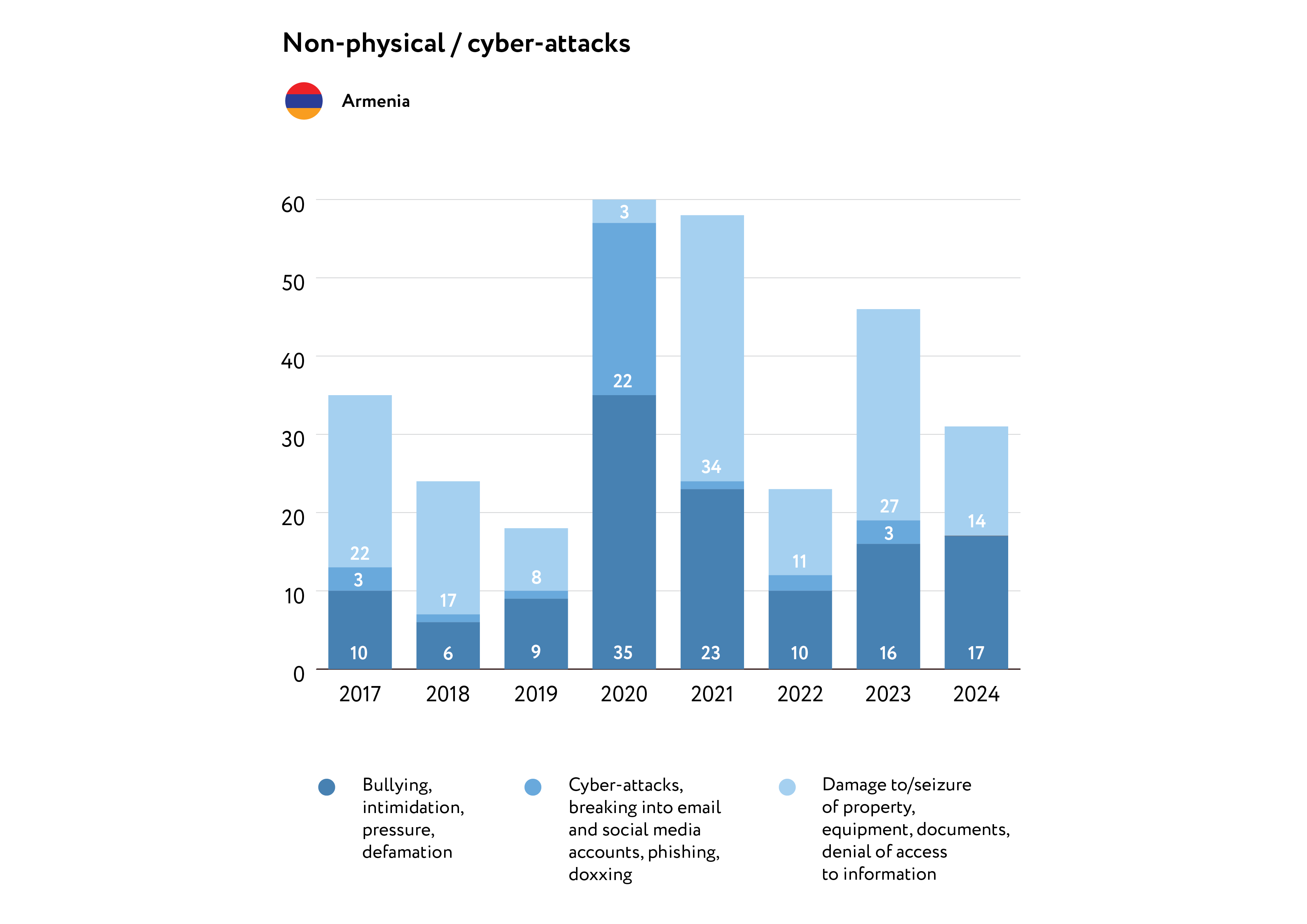
It is worth noting that the overwhelming majority – 74% – of all attacks and threats of a non-physical nature came from government officials. Among these specific incidents were nine cases of illegal obstruction of journalistic activities and denial of access to information; seven cases of harassment, intimidation, pressure and threats, including cyberattacks; three incidents of damage to or seizure of, property, transport, equipment, or documents and two incidents of defamation, dissemination of slander against a journalist or a media outlet. Here are a few examples:
- On 23 January, Liana Sargsyan, a correspondent for the daily newspaper Hraparak, tried to interview Artur Manukyan, a member of the Commission on Television and Radio of Armenia, after an open meeting. However, the chairman of the commission, Tigran Hakobyan, intervened and ordered Manukyan not to answer any questions, then insulted the journalist and her newspaper.
- On 8 April, the editorial board of the daily newspaper Aravot sent a letter to the Government Office with a request to revoke the accreditation of one of Aravot’s journalists and accredit another one, Hripsimeh Jebejyan, in their place. However, the request was rejected, which contradicts both Armenia’s legislation and international norms.
- On 12 July, the Chairman of the National Assembly of the Republic of Armenia, Alen Simonyan, accused the newspaper “Zhoghovurd” on his Facebook page of lying and serving certain political interests. In his post, Simonyan used rude and offensive language and threatened to file a lawsuit against the media outlet.
- In the National Assembly on 15 October, Hovik Aghazaryan, a member of parliament from the ruling Civil Contract faction, approached the parliamentary correspondent of the Zhoghovurd newspaper and the news website Armlur.am, Knar Manukyan, and expressed his dissatisfaction with the way an interview he had given her was presented in her publication. Aghazaryan insulted Manukyan and used offensive language.
- On 22 November, the Yerevan Municipality’s Information and Public Relations Department refused to allow the online television company, Factor TV, to cover the competition for vacant community service positions, even though this was a public event. Quoting a normative act, they said that the editorial staff had to submit an application in advance, yet the said normative act contains no provision for such a requirement.
Attacks and threats of a non-physical nature were perpetrated by individuals not connected with the authorities. There were eight cases recorded of harassment, intimidation, pressure and threats, including cyberattacks, as well as two cases of damage to and seizure of property:
- On 22 February, the Iravunk.com news website reported that for at least a month, the head of the NewsMedia.am news agency, Gayaneh Zargaryan, had been under attack on social media. This included death threats, insults, hate speech and accusations of spying for foreign countries.
- On 29 March, a company video camera was stolen from the apartment of Radio Liberty correspondent Karineh Simonyan. The intruders took nothing else, even though other valuable items were on view in the apartment. Simonian connected the theft with her professional activities and believes it was an attempt to put pressure on her and silence her.
- At a rally organized by the opposition in the Republic Square in Yerevan on 10 May, the leader of the protest movement, Archbishop Bagrat Galstanyan, gave a speech in which he expressed dissatisfaction with media that, according to him, “distorted his words”, and he called the editors of the news website Araratnews.am “scum” and “murderers”.
- On 18 June, members of the opposition movement held protests against the delimitation of the Armenian-Azerbaijani border. They were dispersed by the authorities. They then posted on their Telegram channel a photo of Irina Mkrtchyan, a correspondent of Armenia Public Television, accompanied by offensive comments and accusations of “feeding the public lies”. The opposition activists believed that one of Mkrtchyan’s reports had justified the violence police had used against the protesters.
5/ ATTACKS VIA JUDICIAL AND/OR ECONOMIC MEANS
In 2024, 45 new court cases against journalists and media outlets were opened, a 6% drop compared to 2023. All of these cases are related to administrative prosecution for insulting a person’s honour, dignity or reputation or a violation of privacy. There were also nine hearings related to the removal or blocking of content and/or the release of a refutation, while eight cases were related to the payment of compensation and legal costs in civil lawsuits.
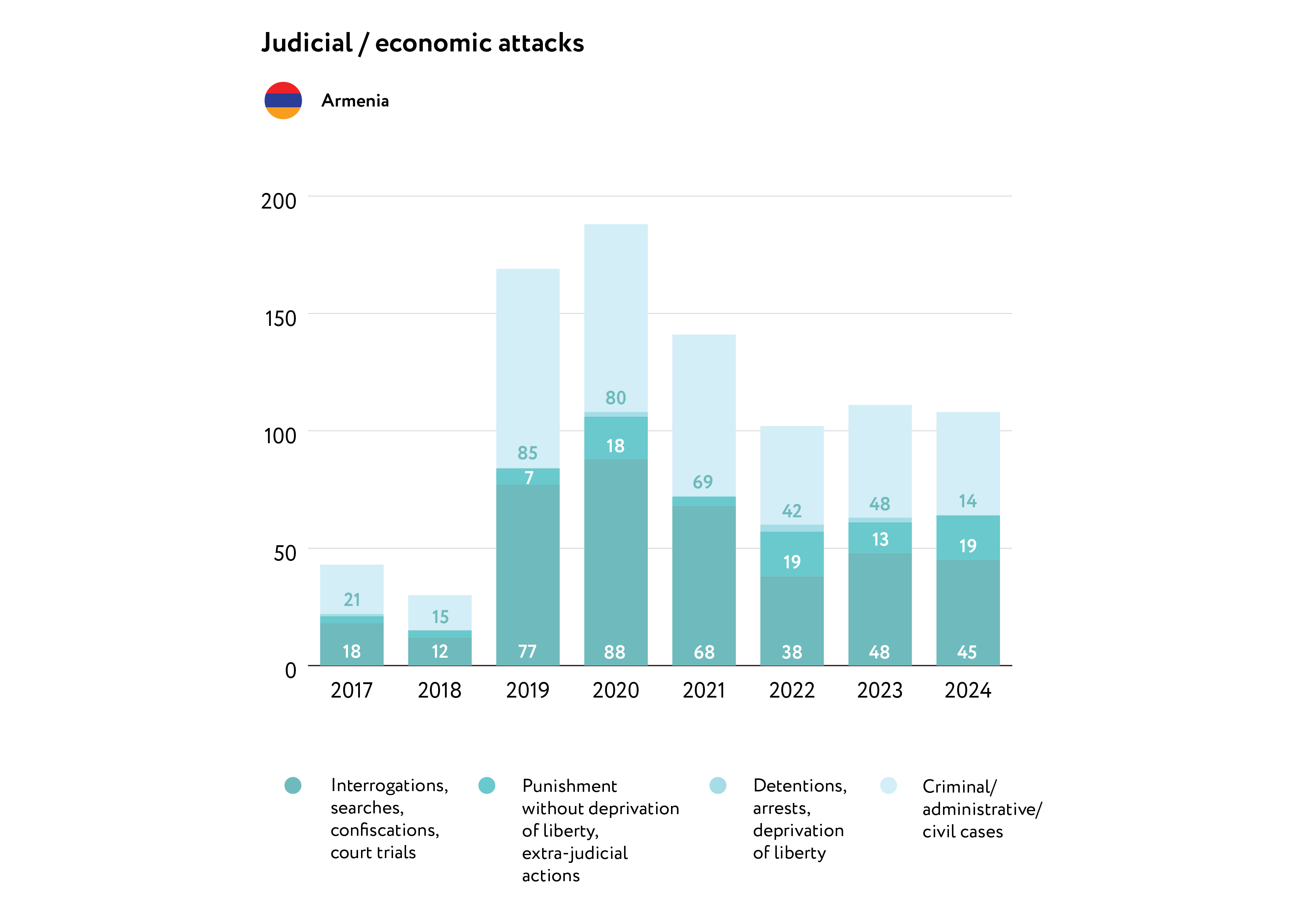
Sixteen of these 45 lawsuits were filed by government officials. Examples of such disputes are:
- On 6 April, Judge of the Criminal Court of Appeal, Rubik Mkhitaryan, filed a lawsuit with the Yerevan Court of General Jurisdiction against the founder of the Pastinfo.am news website demanding a public apology for offensive rhetoric and slander, and calling for compensation of 6 million drams (more than $15,000).
- On 12 June, the Chairman of the National Assembly of the Republic of Armenia, Alen Simonyan, filed a lawsuit with the Yerevan Court of General Jurisdiction against “Yerkir Editorial“ LLC (the founder of the “Yerkir.am” news website) demanding the refutation of information which he considered slander, the payment of compensation of 1 million drams (more than $2,500) and the reimbursement of legal costs for a total amount of 410,000 drams (more than $1,050).
- On 10 December, the Mayor of Yerevan, Tigran Avinyan, filed a lawsuit with the Yerevan Court of General Jurisdiction against the founder of the “Civilnet.am” information portal – part of the “Civilitas” Foundation – demanding a public apology, a refutation of information he considered slanderous, and financial compensation. The lawsuit was filed following the publication of a piece which said that “as Tigran Avinyan’s political career developed, so too did his family’s business”.
But even though government officials filed fewer lawsuits against journalists and media outlets in 2024 than in 2023, the number of lawsuits from commercial enterprises and organizations, businessmen, and other legal entities and individuals increased. The largest number of such lawsuits was filed by the Zangezur Copper-Molybdenum plant (henceforth, “the plant”), which in February 2024 alone initiated six lawsuits against the media. Moreover, independent media experts assessed these actions as Strategic Lawsuits Against Public Participation (SLAPPs) – an attempt to muffle criticism of the mining company. These are a few examples of such lawsuits:
- On 8 February, the plant filed a lawsuit with the Yerevan Court of General Jurisdiction against LLC Datablog, demanding the refutation of information contained in an article published on 9 January on the website Blognews.am (which is owned by LLC). In the article, the plant was accused of subsoil destruction, causing damage to the environment, robbery and creating threats to public health. The plaintiffs regarded this as slander, and called for financial compensation of 6 million drams (about $15,000).
- On 25 February, the plant filed another lawsuit with the Yerevan Court of General Jurisdiction against LLC Datablog, demanding the refutation of information published in an article on the website Blognews.am on January 25, called “ZCMC methodically destroys the south of Armenia: who will grab the thief red handed?”. The plaintiffs regarded the article as defamatory and demanded compensation of 6 million drams (about $15,000).
- Also, on 25 February, the plant filed a lawsuit with the Yerevan Court of General Jurisdiction against LLC”Tert AM“, demanding that they refute information regarded by the plaintiff as slanderous and that they pay 2 million drams (about $5000) as compensation.
- On 19 April, LLC “Pallada Tsaghkadzor” filed a lawsuit with the Yerevan Court of General Jurisdiction against LLC “Editorial Office of Zhoghovurd newspaper”, demanding they refute information regarded by the plaintiff as defamatory and pay 12 million drams (more than $30,000) as financial compensation for causing damage to their honour, dignity and business reputation.
- On 24 May, Vazgen Galstanyan (that is, Archbishop Bagrat Galstanyan of the Armenian Apostolic Church, the leader of the protest movement against Pashinyan’s government) filed a lawsuit with the Yerevan Court of General Jurisdiction against the journalist David Levonyan, and the ruling Civil Contract party, which founded the Civic.am news website. The plaintiff demanded the refutation of information he regarded as slanderous, which was disseminated on 29 April on the defendants’ YouTube channels and on Levonyan’s Facebook page.
In other categories, such as payment of compensation and legal costs in civil suits, the removal or blocking of material, demands for refutations, warnings, pre-trial claims and other extra-procedural actions, the following incidents are worth recording:
- On 19 April, the court partially satisfied the lawsuit filed on 10 June 2019 by citizen Yuri Adyan against the founder of the Zhamanak newspaper, LCC “Skizb Media Kentron”. The plaintiff demanded the refutation of information he regarded as defamatory and the payment of two million drams (more than $ 5,000) as compensation. The court ordered the newspaper to publish a refutation and pay the plaintiff 200,000 drams ($500) as reimbursement of legal fees and 4,000 drams (about $10) as state fees. The rest of the claim was dismissed.
- On 1 November, the court partially satisfied the claim filed on 17 October 2023 by the Zangezur Copper-Molybdenum plant against the founder of the “Oragir.news” news website, Oragir Media LLC, to refute information regarded as slanderous and pay compensation of 6 million drams (about $15,000). The court ordered the defendant to publish a refutation and pay compensation of 200 thousand drams (more than $500). The rest of the claim was rejected.
- On 6 December, the court partially satisfied the claims of the plant, filed on 8 February (two lawsuits), 25 and 29 February, against the founder ofthe “Blognews.am” news website (“Datablog” LLC), demanding a refutation of information regarded by the plaintiff as slanderous, and payment of financial compensation of 21 million drams (more than $ 52,700). The court ordered the website’s editorial office to publish a refutation, to pay the plaintiff 300,000 drams (more than $750) in each claim as compensation for libel, as well as 200,000 drams (more than $500) as compensation for legal fees and 29,000 drams (more than $70) as state duty. In total, the court collected from the defendant 2,116,000 drams (more than $5,300) from the four lawsuits.
- On 24 December, the court partially satisfied the lawsuit filed on 19 August 2022 by the Chief of Staff of the Prime Minister of the Republic of Armenia, Arayik Harutyunyan, against the Hraparak Daily Newspaper LLC. In his claim, Harutyunyan demanded the refutation of information which he regarded as defamatory and the payment of compensation of 2 million drams (more than $5,000). The court ordered the newspaper to publish a refutation and pay the plaintiff 226,000 drams (more than $560), of which 200,000 drams were compensation for slander and 26,000 drams were state fees. The rest of the claim was rejected.
- On 26 December, the State Control Service of the Republic of Armenia (SCS) demanded that the editorial board of the investigative website “Hetq.am” retract an article published the day before, which reported on inspections conducted at the Armenia Medical Centre. The website published the text supplied by the SCS, adding its own comment.
ANNEX 1: OPEN SOURCES USED FOR GATHERING DATA (ARMENIA)
- Committee to Protect Freedom of Expression – a civic organisation operating in Armenia, engaged in studying the situation in the realm of freedom of speech and publishing periodic reports, as well as defending the rights of journalists and media outlets.
- Yerevan Press Club – an NGO, the principal goal of which is support and development of free, independent, and quality media.
- Media Initiatives Center – an Armenian NGO, the main mission of which is to create and disseminate free and independent content and by means of this to promote the all-encompassing and harmonious development of society.
- Hetq.am– the internet publication of the Armenian civic organisation Investigative Journalists.
- Freedom House – an international human rights NGO that evaluates and publishes reports on the level of freedom in 210 countries and territories worldwide, including on freedom of speech and media activity.
- Reporters Without Borders – an international NGO whose aim is to protect journalists who are being subjected to persecution for doing their job.
- The Committee to Protect Journalists – an international organisation engaged in defending the rights of journalists.
- DataLex.am – the database of Armenia’s judicial system.
- Region Research Center – an Armenian civic organisation that studies the regional problems of the South Caucasus, including those concerning media activity.
- Haykakan zhamanak [Armenian Times] – a daily newspaper.
- Factor.am – an Armenian multimedia news portal.
- Radio Azatutyun – the Armenian service of Radio Free Europe/Radio Liberty.
